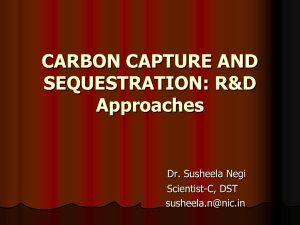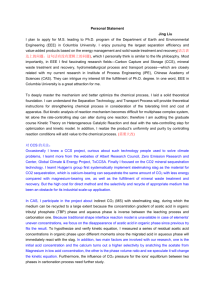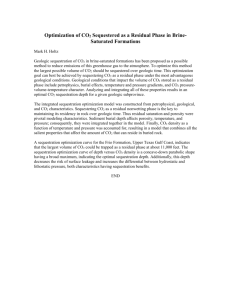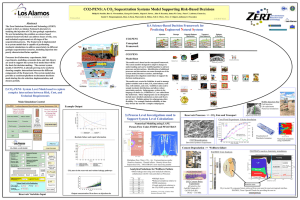Carbon Capture and Storage - McKetta Department of Chemical
advertisement
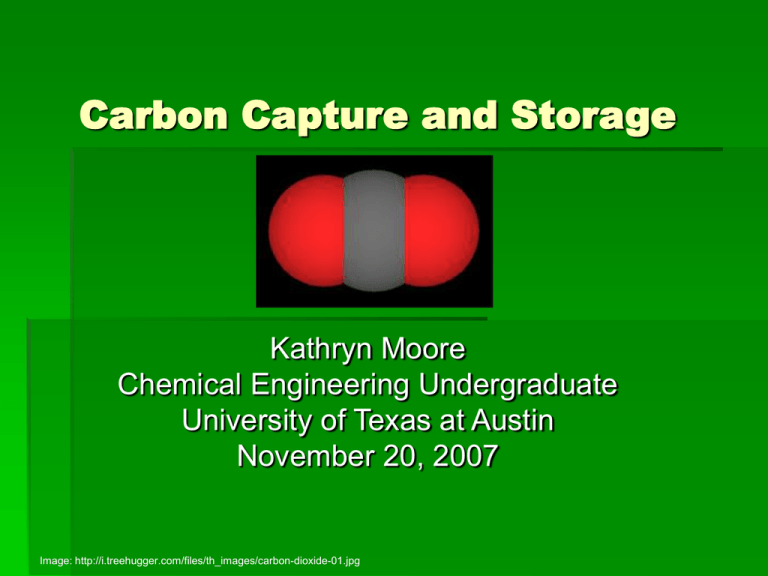
Carbon Capture and Storage Kathryn Moore Chemical Engineering Undergraduate University of Texas at Austin November 20, 2007 Image: http://i.treehugger.com/files/th_images/carbon-dioxide-01.jpg Capture Technologies Chemical Absorption Polymer Membrane Cryogenic Fractionation Pressure Swing Adsorption Storage Technologies Ocean Sequestration Geological Sequestration Future Technologies Reduction of CO2 into Useful Fuels Reduction of CO2 into Formic Acid CARBON CAPTURE: Chemical Absorption Most widely used method of separation Used for low concentrations of CO2 in the flue gas Common Solvent is MEA Steps to Absorption Image: Chemical Absorption Process (USDOE “Scrubbing”) Lean A B S O R B E R Flue Gas S T R I P P E R Rich RB CARBON CAPTURE: Polymer Membrane Porous Inorganic Membranes Steps for Membrane Separation Hollow Fiber Membrane Example Common Solvent is still MEA Image: Schematic Representation of Membrane Contactor for Gas Separation (Xu, et al.) CARBON CAPTURE: Cryogenic Fractionation Separation of gases through cooling until they enter their liquid states Due to different Heats of Vaporization, a liquid/gas mixture can then be separated Used for high concentrations Flue gases typically have low concentrations Information: (Khoo, 2006) CARBON CAPTURE: Pressure Swing Adsorption PSA process High potential Choosing solvents carefully Image: Adsorption of CO2 on Solid Sorbents at Room Temperature (USDOE “Radically”) CARBON STORAGE: Ocean Sequestration Ocean storage depends on depth of injection Vertical Injection Inclined pipeline Dry ice/solid CO2 option Pipe towed by ship Gas Life Advanced Dissolution (GLAD) method Hydrate option Emulsion option Information: (Anna, 2002) CARBON STORAGE: Geological Sequestration Image: Options for Storing CO2 in Deep Underground Geological Formations (IPCC) FUTURE TECHNOLOGIES: Reduction into Useful Fuels Brookhaven National Laboratory CO2 + Solar Energy > Hydrocarbons? Reduction into Formic Acid University of Leeds in England CO2 [+ Hydrogen] > Formic Acid? Information: (Ritter, 2007) Conclusions Carbon Capture Conclusions Carbon Storage Conclusions Future Technology Goals THANK YOU FOR LISTENING! Works Cited Anna, David. “New Projects to Explore ‘Breakthrough’ Ideas for Capturing, Storing Carbon Gases.” National Energy Technology Laboratory News Release 6 Mar. 2002. 30 Oct. 2007 <http://www.netl.doe.gov/publications/press/2002/tl_sequestration_baa2002.html>. Intergovernmental Panel on Climate Change. IPCC Special Report on Carbon Dioxide Capture and Storage. 30 Oct. 2007 <http://www.ipcc.ch/activity/srccs/index.htm>. Khoo, Hsien H., and Reginald B. H. Tan. “Life Cycle Investigation of CO2 Recovery and Sequestration.” Environmental Science & Technology 40.12 (May 2006): 40164024. American Chemical Society. 30 Oct. 2007 <http://pubs.acs.org/cgibin/abstract.cgi/esthag/2006/40/i12/abs/es051882a.html>. Ritter, Stephen K. “What Can We Do With CO2?” Chemical & Engineering News 85.18 (Apr. 2007): 11-17. U. S. Department of Energy. National Energy Technology Laboratory. Radically New Adsorption Cycles for Carbon Dioxide Sequestration. By James A. Ritter. 30 Oct. 2007 <http://www.netl.doe.gov/publications/proceedings/04/UCRHBCU/presentations/Ritter_P.pdf>. U.S. Department of Energy. National Energy Technology Laboratory. Scrubbing CO2 from Power Plant Flue Gas Using Monoethanolamine (MEA). By Damon Benedict and Curt M. White. DOE Office of Fossil Energy. DOE Office of Energy Efficiency & Renewable Energy. 30 Oct. 2007 <http://www.netl.dow.gov/newsroom/backgrounder/mb-0002.html>. XU, Zhikang, et al. Separation and Fixation of Carbon Dioxide Using Polymeric Membrane Contactor. Natural Science Foundation of China. Institue of Polymer Science, Zhejiang University. 30 Oct. 2007 <http://www.netl.doe.gov/publications/proceedings/01/carbon_seq/p56.pdf>.

